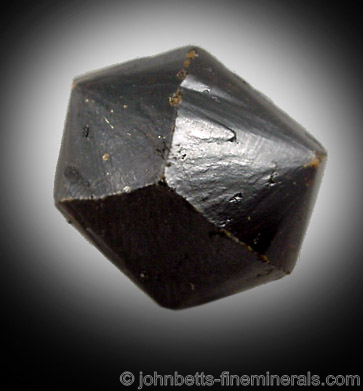The Mineral sphalerite

Sphalerite is a common mineral, and occurs in many distinct colors and forms. Iron impurities are often present in this mineral, and for this reason it is not commonly transparent. If Sphalerite contains a large amount of iron impurities, it will have a metallic dark gray or black color, which is typical of most sulfide minerals. Sphalerite is one of the few minerals that can range from gemmy transparent crystals to dark, metallic-black crystals.
An interesting variety of Sphalerite is known as Schalenblende. Schalenblende is banded variety associated with Wurtzite and often also Pyrite and Galena that forms strange concentric shapes. It is often polished into slabs or cross-sections which are very popular with collectors. Schalenblende is known from a select few mineral in Europe, most notable is the Segen Gottes Mine, Wiesloch, Baden-Württemberg, Germany.
Chemical Formula
ZnS
The above is the formula of pure Sphalerite. However, since it usually occurs with some iron replacing the zinc, its formula can be more accurately described as (Zn,Fe)S
Color
Black, brown, red, orange, yellow, green, gray. Rarely colorless. Some specimens contain crystals of different colors, and there is also a brown, globular, banded variety.
Additional Information
Composition
Zinc sulfide, usually with some iron, sometimes with magnesium, manganese. In a few rare localities, it contains cadmium, indium, and gallium. |
In Group
Sulfides; Simple Sulfides |
Striking Features
Color and luster, crystal forms, and streak |
Environment
In sedimentary limestone deposits, hypothermal veins and mesothermal veins, and in hydrothermal replacement deposits. Occasionally in basalts.
|
Rock Type
Igneous, Sedimentary, Metamorphic |
Varieties
-
Transparent, lightly colored variety of Sphalerite.
-
Red variety of Sphalerite that is transparent to translucent.
Uses
Sphalerite is the principle ore of zinc. In some localities, it occurs with significant amounts of the rare elements cadmium, gallium, and iridium, and it is also the main ore of those metals. Sphalerite is an important mineral to collectors, and some transparent varieties are occasionally faceted for collectors.
Noteworthy Localities
Sphalerite is a common mineral, and there are many localities where fine specimens have come from. Notable European occurrences include the Aliva Mines, Picos de Europa Mountains, Camaleño; and the Troya Mine, Mutiloa, Spain; Alston Moor, Cumberland, England; and the Lengenbach Quarry, Binn Tal, Wallis, Switzerland. Other classic European localities are Trepca, Croatia (former Yugoslavia); the Madan ore field, Rhodope Mts, Bulgaria; the Herja Mine, Baia Mare; and the Turt Mine, Satu Mare; and Kapnick, all in Maramures Co., Romania. Banded Schalenblende has come from the Segen Gottes Mine, Wiesloch, Baden-Württemberg, Germany; the Schmalgraf Mine, Kelmis, Belgium; and Olkusz, Poland.
China has recently become a significant producer of Sphalerite specimens, most notably at Kangjiawan, Shuikoushan ore field, Hunan Province; the Taolin Mine, Yueyang, Hunan Province; and Nandan, Guangxi Province.
In Peru, excellent Sphalerite comes from the Huaron Mines, Cerro de Pasco. In Mexico, large iron-rich, crystals associated with Galena were found in Santa Eulalia and Naica, Chihuahua, Mexico.
In Canada, good specimens have recently come from the rock dump of the hydroelectric station canal at Niagara Falls, Ontario. Good examples also come from the Lafarge Quarry, Dundas, Ontario, and Mont Saint Hilaire, Quebec.
In the U.S., some of the finest specimens come from the tri-state mining district of Missouri, Kansas, and Oklahoma. These areas include the Joplin area, Jasper Co., Missouri; Treece, Galena, and Baxter Springs, Cherokee Co., Kansas; and Picher, Ottawa Co., Oklahoma. Two other notable Midwestern regions are the Elmwood and Gordonsville Mines, Carthage, Smith Co., Tennessee; and the Denton mine and Cave-in-Rock, Hardin Co., Illinois.
In Colorado, fine Sphalerite has come from the Commodore and Bachelor Mines, Creede District, Mineral Co; and the Eagle Mine, Gilman, Eagle Co. Dark green crystals come from the Iron Cap Mine in Graham Co., Arizona. New York State has some noteworthy occurrences, especially Balmat and Pierrepont, St. Lawrence Co., the Redlands Quarry, Niagara Falls, Niagara Co.; and the Walworth Quarry, Wayne Co. Many specimens also have come from Franklin and Ogdensburg, Sussex Co., New Jersey.
Distingushing Similar Minerals
Galena - Heavier (7.4 - 7.6), has a gray streak, has a distinct bluish metallic color.
Siderite - Lacks brown streak, has different crystals and cleavage.
Tetrahedrite - Has a dark gray streak.
Argentite - Has a shiny black streak, is sectile and malleable.